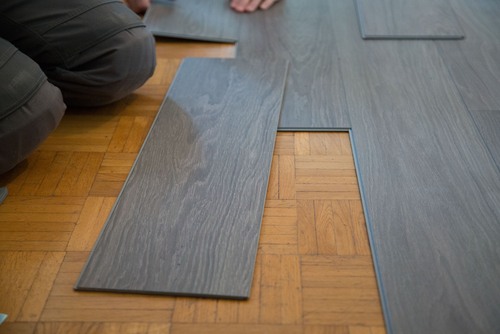

– Can be cleaned using steam mops or wet mops. – Avoid using in bathrooms, kitchens, and laundry rooms (if not waterproof) – Floating click and lock (need underlayment).

– Floating click and lock, peel-and-stick. May also chip at the corners with extensive wear.- New waterproof products just hitting the market. – Can feel cold if directly installed on the subfloor without insulation. – Better for areas with moisture such as bathrooms and kitchens. – Can be cut to size using a handsaw or circular saw. – Widths start at 4 inches and can reach up to 16 inches. – Can be cut to size using a utility knife. Also available in travertine, ceramic, and stone styles. – Available in a variety of wood styles, including oak, mahogany, and cherry. – Better, more realistic appearance and styles. – Larger selection of products and SKUs on the market. READ NEXT: Laminate Flooring Buying Guide Side-By-Side Comparison: Key Differences Between Laminate and Vinyl Flooring

While not as popular as other types of flooring, laminate flooring is a great option you should consider if you want the look and feel of hardwood, but at an affordable price point. Most laminate manufacturers utilize modern printing techniques to give their products a more realistic look and texture. Laminate is wood but its design is on top of it, on a photographic layer. READ NEXT: Vinyl Flooring Buying Guide What Is Laminate Flooring? Some brands have questionable environmental credentials.As the material is 100% synthetic, the public perception could lead to lower resale value vs.Buying a wear layer less than 12 mils may lead to increased wear and the need for a replacement sooner.WPC and SPC vinyl flooring are 100% waterproof (ensure the brand you choose is waterproof vs.Variety of styles and designs that mimic the look of wood, tile, and stone.Cost: quality vinyl flooring costs at least $3 per sq.
Do it yourself sheet vinyl vs laminate flooring install#
Easy to install (most are click and lock).Thus, vinyl flooring is much more popular amongst consumers when compared to laminate flooring which represents only ~3.6% of the total market. According to the Statista Research Department, luxury vinyl flooring sales in the United States from 2014-2020 were ~ $5.3 billion dollars which represented about 20% of the total floor covering market. Vinyl flooring is a terrific choice if you are looking for a floor that is durable, easy to install, and affordable. This includes color variations, textures, and patterns that replicate the appearance of wood at a fraction of the cost and with all of the benefits previously covered. However, manufacturers have used the latest technology to give a realistic look to vinyl. The creation of vinyl planks does not involve wood. So what’s the difference between vinyl and laminate flooring? Let’s start by defining what these types of flooring are along with their pros and cons. Laminate vs Vinyl Flooring: Definition, Pros, and Cons


 0 kommentar(er)
0 kommentar(er)
